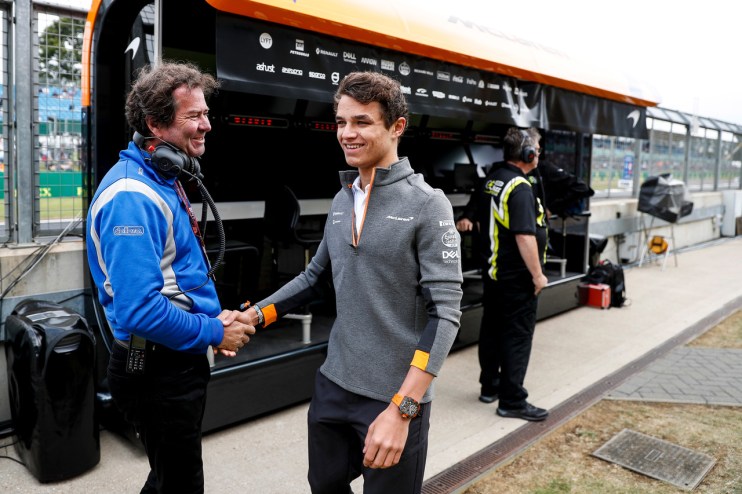Trevor Carlin interview: IndyCar and F2 team owner on the impact of coronavirus, developing F1 stars and which protege has world title potential

They have played a crucial role in the development of a number of Formula One stars, from former world champions Sebastian Vettel and Nico Rosberg to rising stars such as Lando Norris and Carlos Sainz Jr.
But that has not made celebrated motor racing outfit Carlin impervious to the financial difficulties that the coronavirus crisis is posing to a vast range of organisations, both within and outside of sport.
Carlin are one of the biggest teams not operating in F1 and operate in multiple Formula racing championships. Like many of the independent teams in the industry, however, the small margins on which they operate leave them vulnerable if revenue runs dry.
Their founder and owner, Briton Trevor Carlin, was about to board his flight to the United States last week for the first IndyCar race of the season when news broke of the Australian Grand Prix’s uncertainty.

“I went to the gate and the phone just went mental with McLaren news and the Australian Grand Prix. It seemed to have a domino effect around the world,” Carlin tells City A.M. “[IndyCar] pretty much cancelled within hours, it all fell apart.”
The subsequent postponement of the Bahrain Grand Prix meant the start of both supporting Formula Two and Formula Three series have also been delayed and could see vital sponsorship income held up.
“I’ve got a skeleton crew in the factory to get the cars prepared and doing factory maintenance, and then I’d expect in a week we’ll probably have to close down as well,” Carlin said earlier this week.

“If the cars aren’t running, then sponsors have no reason to pay. They’ll probably start delaying payments and then we’re on a bit of a knife-edge financially.
“If it goes on for six months there’s a chance the team won’t exist. Hopefully it won’t be six months but the whole industry is on a knife-edge. But motor racing is one thing at the end of the day – everyone’s livelihoods are at stake.”
Clear Trajectory
Carlin, 57, began his career working part-time for a local Formula Ford team before landing a job as team manager of a British F3 team in 1988. Almost a decade later Carlin was approached with an offer to run his own team by the father of a driver, who funded the venture so that his son could race.
“The last thing I wanted to do was call it after myself,” he laughs. “I looked at other teams and all the good ones were named after the boss so I thought it’s a bit predictable but went with it.”
Despite lasting just six months, Carlin was back a year later in 1998 with renewed backing and a full team. This time, they were here to stay.
Since then the Surrey-based outfit has continued to expand and now has teams in the Le Mans Series, IndyCar and multiple single-seater series preceding F1.

There is a clear trajectory for drivers to progress. The latest example is McLaren driver Norris, who joined Carlin in Formula Four as a 15-year-old and worked his way up the ranks.
There are a whole host of success stories, with Daniel Ricciardo, double Formula E champion Jean-Eric Vergne, joining Vettel and Rosberg in the team’s hall of fame. Robert Kubica, Sainz Jr, Takuma Sato, Anthony Davidson, Max Chilton, Jaime Alguersuari and Kevin Magnussen also passed through Carlin on their way to F1.
Full Package
Selecting drivers is invariably a “budget-led decision”, with the funding provided by them and sponsors crucial. But it is also a results-driven decision: prize money is also important, which is one of the reasons Carlin require more from their IndyCar exploits if they are to continue.
“There’s no real blueprint, but once you’ve had them in the car for at least, maybe even just one test session, you can just tell,” he says.
“They’re no fuss, no trouble, know exactly what they want and they get up to speed easily. Other guys need thousands of laps but the real good guys are on the pace within 10 to 20 laps — and that’s what you look for.”
Of the current crop of ex-Carlin drivers in Formula One, the 57-year-old says Norris and Sainz are “making great strides” but it is Ricciardo who is best equipped to challenge for a title, if given the right car.

“I would love to see Ricciardo in a top car because I think he’s the full package, his race craft is very good,” Carlin says, adding that it depends “who can get the right seat” when the new rules come into effect in 2021, or possibly 2022, if current factory closures halt development.
Unfortunately, the “ridiculous” cost of getting into F1 has prevented Carlin taking that final step – IndyCar is “peanuts” in comparison – but it hasn’t stopped Carlin cheering on those he has helped nurture.
While the team already have a number of proteges in F1, there are more coming along the Carlin conveyor belt. This season’s F2 team is made up of Red Bull junior driver Jehan Daruvala, of India, and Honda-supported “hot property” Yuki Tsunoda, from Japan.
“They both have great potential,” he says. “I could see those two very quickly making it into Formula One.”
They will have this season – if and when it happens – to showcase their potential for joining the illustrious names in Carlin’s hall of fame.